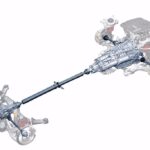Slide 1. Introduction.
The class discusses what a vehicle technical data sheet is, why it is so important, and its implications for fleet management.
Slide 2. Vehicle technical data sheet.
- A very important document.
Owning and driving a car requires several documents to be up to date, such as the technical specifications, to avoid problems with the traffic authorities. This document contains the manufacturing and inspection data that authorize the vehicle to be driven in accordance with regulations.
A vehicle's technical specifications are a document containing detailed information about the technical and specific characteristics of a vehicle. This document is usually provided by the vehicle manufacturer and offers consumers and traffic authorities a detailed overview of the car's specifications.
It is also essential to bear in mind that it is mandatory to carry it with you when driving the vehicle. Failure to present it when requested by the authorities will result in a fine. Therefore, if it is damaged, lost, or stolen, you must request a duplicate of the technical specifications immediately.
The technical data sheet also plays an important role in recording any modifications made to the vehicle after its manufacture. This ensures that such modifications comply with the relevant legal and safety regulations, avoiding potential legal problems or safety risks.
The following section discusses the case of Spain, which is the same or similar in any country.
- Technical specifications.
From engine power to safety certifications, we will break down everything you need to know to interpret it correctly. To interpret it, follow these steps.
- Identify the basic information.
Make, model, year of manufacture, chassis number, etc.
Start by locating the basic vehicle data, such as the make, model, year of manufacture, chassis number, etc. This section provides you with an overview of the vehicle.
- Study the technical specifications.
Carefully examine the technical specifications, which include data such as engine power, fuel type, tank capacity, vehicle weight, etc. These details will help you understand the car's performance and capabilities.
- Analyze the codes and approvals.
Codes and approvals indicate whether the vehicle complies with safety regulations and standards. Make sure you understand what these codes mean and whether the car meets the required standards.
- Review the observations and modifications.
This section usually includes observations about modifications made to the vehicle after it was manufactured. It may contain details about changes to the engine, bodywork, or other key parts. It is crucial to understand these modifications in order to assess their impact on the car's performance and legality.
- Verify the signatures and authorization stamps.
The authorized signatures on the technical data sheet confirm the validity and authenticity of the document. Make sure that all signatures are present and legitimate, as this guarantees that the information provided is accurate and reliable.
- The most common codes.
One of the most challenging tasks when reviewing the technical data sheet is understanding the codes used to simplify the information. From the manufacturer's name to the vehicle's fiscal power, each code refers to a specific aspect of the vehicle, such as the maximum weight it can carry, tire sizes, vehicle height and width, among others.
The alphanumeric codes in the new technical data sheet are regulated by Annex XII of Royal Decree 750/2010. Although there are nearly 80 possible entries, here are the most common ones.
A.1: Manufacturer name
D.1: Vehicle brand
D.2: Version and variant
D.3: Commercial name
E: Vehicle identification number (chassis)
G: Mass in running order
J: Vehicle category
P.2: Maximum power (in kW)
P.3: Fuel type
R: Color
V.7: CO2 emissions
V.9: Emission level according to regulations
In the case of elements such as the exhaust system, parts are also recorded in the form of codes according to their type, configuration, and emission level.
To find out what the codes mean, you have several options: you can look directly at the back of the technical data sheet, if you have it printed on A4 paper, where there is usually an explanatory key. Another option is to consult Royal Decree 750/2010, or go to an MOT station or an authorized workshop if you need help deciphering a specific code.
- Implications for fleet management.
The main consequence of not having the technical specifications in the vehicle is the cost of the fine, and failing the MOT if it is not presented.
The following measures are recommended.
- Check that the vehicle has the technical specifications.
From time to time, you should check that the vehicle has the printed technical specifications, which must be kept with the rest of the vehicle's documentation.
If the technical specifications are electronic, you should also check that they are available in the General Directorate of Traffic's application.
- Duplicate of the technical specifications.
In my experience as a fleet manager, vehicle documentation tends to get lost, so it is recommended that a duplicate of the technical data sheet be kept in the vehicle and that the fleet manager keep the original.
- Driver training.
Drivers must be trained on the documentation that the vehicle must have, such as the technical specifications, the registration certificate, and the driver's license, in case they have to present it to the traffic authorities on the road or at the ITV.
- General Directorate of Traffic app.
Activate the General Directorate of Traffic app if the vehicle has an electronic technical specifications sheet available.
- Loss of the technical specifications sheet.
If the technical specifications sheet is lost, a new one must be requested immediately.
- Always keep the technical specifications sheet in the glove compartment of the car.
Keep it in a plastic sleeve or transparent envelope. This will prevent it from becoming creased, wet, or damaged over time. Do not remove it from the vehicle unnecessarily, and if you do, make sure you return it to its place immediately. Many losses occur because it is left behind after a service or procedure.
- Avoid leaving it in areas where it may be exposed to direct sunlight.
Over time, the ink may fade or the paper may deteriorate.
In summary, the vehicle registration document is one of the most important documents you must keep in order. Not only does it help you avoid penalties, but it is also necessary for administrative procedures, taking out insurance, or taking your car to the repair shop.
Knowing the codes on the new vehicle registration document will help you better understand your vehicle, make decisions about repairs or replacements, and ensure that everything is in order for any inspection or sale.
Slide 3. Thank you for your time.
The class has developed what a vehicle registration document is, why it is so important, and its implications for fleet management, see you soon.
Download the audio




















